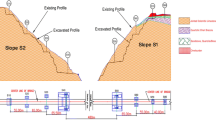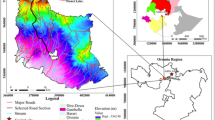Abstract
This article presents the challenges encountered during the stability analysis and stabilization of two Himalayan rock slopes supporting the Chenab Railway Bridge in India, which will be the highest railway bridge in the world after completion. Owing to the importance of the project, extensive geological investigations, in situ and laboratory tests were carried out using conventional and advanced methods to evaluate various intact rock, rock joints, rock mass properties and rock mass quality present at the site. Once the conclusive results were made regarding these properties, stability of slopes were evaluated against both structurally controlled and stress-controlled failures using the developed probabilistic approach due to the presence of high variability in intact rock, rock mass and rock joints properties. It was observed that while the slopes were stable against stress-controlled failures, the possibility of structurally controlled failures exists as observed in the probabilistic approach in which the conventional deterministic approach was not able to detect. Different stabilization measures, i.e. rock bolts, slope flattening, grouting, drainage and shotcreting, were designed at the site to reduce the probability of failures for the slopes, deformability of rocks present due to cavities and high aperture joints, shallow block failures along the slope surface and pore-pressure build-up. To check the efficiency of the stabilization measures, cross-hole seismic tomography is carried out at the site and further in situ measured displacements are compared with the displacements estimated using the developed probabilistic approach. The case study used in this paper is a real-time ongoing bridge project of global interest and the data and analysis presented will be of great benefit to the researchers and practitioners working on similar problems.


















Similar content being viewed by others
References
Ahmdabadi M, Poisel R (2015a) Assessment of the application of point estimate methods in the probabilistic stability analysis of slopes. Comput Geotech 69:540–550
Ahmdabadi M, Poisel R (2015b) Probabilistic analysis of rock slopes involving correlated non-normal variables using point estimate methods. Rock Mech Rock Eng 49(3):909–925
Bhasin R, Kaynia AM (2004) Static and dynamic simulation of a 700 m high rock slope in western Norway. Eng Geol 71:213–226
Bieniawski ZT (1978) Determining rock mass deformability: experience from case histories. Int J Rock Mech Min Sci Geomech Abstr 15:237–247
Dai SH, Wang MO (1992) Reliability analysis in engineering applications. Reinhold, New York
Duzgun HSB, Bhasin RK (2009) Probabilistic stability evaluation of Oppstadhornet rock slope, Norway. Rock Mech Rock Eng 42:729–749
Fisher SR (1953) Dispersion on a sphere. Proc R Soc Lond A Math Phys Sci 217:295–305
GSI (1989) Geological survey of India. Special Publication no, 26
Hoek E (1983) Strength of jointed rock masses. Géotechnique 23(3):187–223
Hoek E (2007) Practical rock engineering. Hoek’s corner. Rocscience Inc., Ontario
Hoek E, Brown ET (1988) The Hoek-Brown failure criterion-a 1988 update. In: Proceedings of 15th Canadian Rock Mechanics Symp,Toronto
Hoek E, Carranza-Torres C, Corkum B(2002) Hoek–Brown failure criterion-2002 edition. In: Proceedings of Int. Conf. Fifth North American Rock Mechanics Symposium, Toronto
Hoek E, Diederichs MS (2006) Empirical estimation of rock mass modulus. Int J Rock Mech Min Sci 43:203–215
Hong HP (1998) An efficient point estimate method for probabilistic analysis. Reliab Eng System Saf 59:261–267
Hudson AJ, Harrison JP (1997) Engineering rock mechanics-an introduction to the principles. Elsevier, Oxford
Indraratna B, Jayanathan M (2005) Measurement of pore water pressure of clay-infilled rock joints during triaxial shearing. Geotechnique 55(10):759–764
IS 1893 (2002) Criteria for earthquake resistant design of structures. Indian Standard Code by Bureau of Indian Standards, New Delhi
ISRM (1981) Rock characterizition, testing and monitoring. In: Brown ET (ed) ISRM suggested methods. Pergamon, New York
Kemeny J, Post R (2003) Estimating three-dimensional rock discontinuity orientation from digital images of fracture traces. Comput Geosci-UK 29:65–77
Kulatilake PHSW (1985) Fitting Fisher distributions to discontinuity orientation data. J Geol Educ 33:266–269
Lichtenstein S, Newman JR (1967) Empirical scaling of common verbal phrases associated with numerical probabilities. Psychon Sci 9(10):563–564
Mantrala S, Verma AK, Sitharam TG (2018) A systematic approach for the analyses and design of jointed rock mass slopes against wedge and toppling failures: a case study of the stability of the abutments of the bridge across the Chenab River. Int J Geotech Eng. https://doi.org/10.1080/19386362.2018.1480151
Nicholson GA, Bieniawski ZT (1990) A nonlinear deformation modulus based on rock mass classification. Int J Min Geol Eng 8:181–202
Palisade Co. (2015) @RISK, v 7.5. Palisade Corporation. https://www.palisade.com/
Palmstrom A, Singh RB (2001) The deformation modulus of rock masses-comparisons between in situ tests and indirect estimates. Tunn Undergr Space Technol 16(3):115–131
Papaliangas T, Hencher SR, Lumsden AC, Manolopoulou S (1993) The effect of frictional fill thickness on the shear strength of rock discontinuities. Int J Rock Mech Min Sci Geomech Abstr 30:81–91
Park HJ, Terry RW, Woo IK (2005) Probabilistic analysis of rock slope stability and random properties of discontinuity parameters, interstate highway 40, Western North Carolina, USA. Eng Geol 79:230–250
Park H, West TR (2001) Development for a probabilistic approach for rock wedge failure. Eng Geol 59:233–251
Priest SD (1993) Discontinuity analysis for rock engineering, vol 473. Chapman & Hall, London
Quinones-Rozo C (2010) Lugeon test interpretation, revisited. In: Proceedings of the collaborative Management of Integrated Watersheds, 30rd annual USSD (United States society on dams) conference. US Society on Dams, Denver
Ramamurthy T (2004) A geo-engineering classification for rocks and rock masses. Int J Rock Mech Min Sci 41:89–101
Read SAL, Richards LR, Perrin ND (1999) Applicability of the Hoek-Brown failure criterion to New Zealand greywacke rocks. In: Proceedings of the Int. Cong on Rock Mech Paris, France
Ribacchi R (2000) Mechanical tests on pervasively jointed rock material: insight into rock mass behaviour. Rock Mech Rock Eng 33(4):243–266
Rocscience (2014a) Dips version 6.015, graphical and statistical analysis of orientation data. Rocscience Inc., Ontario
Rocscience (2014b) SWEDGE version 6.003, 3D surface wedge analysis for slopes. Rocscience Inc., Ontario
Rocscience (2014c) Phase2 version 8.020, finite element analysis for excavations and slopes. Rocscience Inc., Ontario
Rocscience (2014d) SLIDE version 6.003, 2D limit equilibrium slope stability analysis. Rocscience Inc., Ontario
Rosenblueth E (1975) Point estimates for probability moments. Proceedings of the Conf. Natl. Acad. Sci, USA
Sakurai S (2017) Back analysis in rock engineering. CRC/Balkema, Leiden
Serafim JL, Pereira JP (1983) Consideration of the geomechanics classification of Bieniawski. Proceedings of the Int. Sym. on Eng. Geol. Undergr. Const., Lisbon, Portugal
Sonmez H, Gokceoglu C, Ulusay R (2004) Indirect determination of the modulus of deformation of rock masses based on the GSI system. Int J Rock Mech Min Sci 41:849–857
Tiwari G, Latha GM (2016) Design of rock slope reinforcement: an Himalayan case study. Rock Mech Rock Eng 49(6):2075–2097
US Army Corps of Engineers (1999) Risk-based analysis in geotechnical engineering for support of planning studies, engineering and design. Rep. No. 20314–1000. Dept. of Army, Washington, D.C.
Wolff TF (1996) Probabilistic slope stability in theory and practice. In: Proceedings of Conf. On uncertainty in the geologic environment. Uncertainty, Madison
Wyllie DC, Christopher WM (2005) Rock slope engineering. Spon, London
Zheng J, Dang J, Yang X, Wei J, Zheng H, Cui Y (2014) An improved Monte Carlo simulation method for discontinuity orientations based on Fisher distribution and its program implementation. Comput Geotech 61:266–276
Author information
Authors and Affiliations
Corresponding author
Appendix
Appendix
Steps Involved in Reliability Index Calculation for Stress-Controlled Failures of Slopes

Brief Details of Hong’s Point Estimate Method
Hong’s PEM can be briefly summarized in the following steps:
- (1)
Evaluate the parameter ζi
$$ {\zeta}_i=\sqrt{n+{\left(\frac{v_i}{2}\right)}^2} $$(A1)where n = number of random variables, νi= skewness coefficient of the random variable Xi.
Skewness coefficient of the random variable Xi can be estimated as:
$$ {v}_i=\frac{E\left[{\left({x}_i-{\mu}_i\right)}^3\right]}{\sigma_i^3} $$(A2)where μi = mean value of random variable; σi = Standard deviation of random variable.
- (2)
Evaluate the two evaluation points for each random variable
$$ {x}_{i,1}={\mu}_i+\left(\frac{v_i}{2}-{\zeta}_i\right)\cdot {\sigma}_i $$(A3)$$ {x}_{i,2}={\mu}_i+\left(\frac{v_i}{2}-{\zeta}_i\right)\cdot {\sigma}_i $$(A4)xi, 1, xi, 2 = evaluation points for each variable.
- (3)
Calculate corresponding weights for each model output to compute statistical moments of the performance functions:
$$ {p}_{i,1}=\frac{1}{2n}\left(1+\frac{v_i}{2{\zeta}_i}\right) $$(A5)$$ {p}_{i,2}=\frac{1}{2n}\left(1-\frac{v_i}{2{\zeta}_i}\right) $$(A6) - (4)
Compute the mth statistical moment of the factor of safety E(FOSm)
$$ \boldsymbol{E}\left({\boldsymbol{FOS}}^{\boldsymbol{m}}\right)={\sum}_{\boldsymbol{i}=\mathbf{1}}^{\boldsymbol{n}}{\sum}_{\boldsymbol{j}=\mathbf{1}}^{\mathbf{2}}{\boldsymbol{p}}_{\boldsymbol{i},\boldsymbol{j}}\times {\left[\boldsymbol{FOS}\left({\boldsymbol{\mu}}_{\mathbf{1}},\dots {\boldsymbol{x}}_{\boldsymbol{i},\boldsymbol{j}}\dots, {\boldsymbol{\mu}}_{\boldsymbol{n}}\right)\right]}^{\boldsymbol{m}} $$(A7)where E is expectation operator, FOS is Factor of Safety.
- (5)
Calculate the reliability index (β)
$$ \beta =\frac{\mathit{\ln}\left(\frac{\mu_{FOS}}{\sqrt{1+{COV}^2}}\right)}{\sqrt{\mathit{\ln}\left(1+{COV}^2\right)}} $$(A8)where μFOS = mean factor of safety; σFOS = standard deviation of factor of safety; COV= \( \frac{\sigma_{FOS}}{\mu_{FOS.}} \)
Rights and permissions
About this article
Cite this article
Tiwari, G., Latha, G.M. Stability analysis and design of stabilization measures for Chenab railway bridge rock slopes. Bull Eng Geol Environ 79, 603–627 (2020). https://doi.org/10.1007/s10064-019-01602-2
Received:
Accepted:
Published:
Issue Date:
DOI: https://doi.org/10.1007/s10064-019-01602-2




